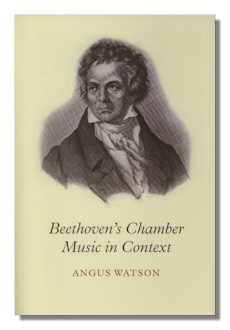
The Internet's Premier Classical Music Source
Related Links
-
Introduction
Acoustics
Ballet
Biographies
Chamber Music
Composers & Composition
Conducting
Criticism & Commentary
Discographies & CD Guides
Fiction
History
Humor
Illustrations & Photos
Instrumental
Lieder
Music Appreciation
Music Education
Music Industry
Music and the Mind
Opera
Orchestration
Reference Works
Scores
Thematic Indices
Theory & Analysis
Vocal Technique
Search Amazon
Recommended Links
Site News
 Book Review
Book Review
Beethoven's Chamber Music in Context

Angus Watson
Boydell Press, 2010 xii + 306pp
ISBN-10: 1843835770
ISBN-13: 978-1843835776
Three aspects of Angus Watson's splendid new study of Beethoven's chamber music corpus from the admirable publishers, Boydell, stand out. In the first place, Watson is a violinist (and conductor) with intimate first hand experience of the repertoire. Although he considers Beethoven's works developmentally, he really does put them in the context of the composer's life, musical career and of prevailing wider musical trends. Then, it's an up-to-date study, produced to high scholarly standards, which combines nicely the encyclopedic (every movement is described factually, analytically, and with ample illustration) with the narrative (biographical, with reference to other works by Beethoven and his contemporaries, and with reference to and use of primary sources).
Almost as potent in recommending Beethoven's Chamber Music in Context to the general and specialist reader is the fact that, although the late string quartets (in particular) are recognized for the great and ground-breaking triumphs that they are, Watson in no way glosses over the earlier works, nor suggests that the composer was always working towards them. That's the nature of what Beethoven achieved; it's also a strength of Watson's approachable style. Really to get the most from this exciting and valuable book, read it all; although it is also possible to pick up the book to work on a single work or group of works.
It's divided into six parts; the first sets the scene for Beethoven's arrival in Vienna in 1792, his accomplishments that far and how they – and the Viennese environment – equipped him for what was to follow. Then the book is divided into periods unequal in timespan covered but which correspond well to Beethoven's compositional history: 1793-1799; 1800-1803; 1804-1809; 1810-1815; 1816-1827. With the exception of the last period, which deals only with the late quartets, each part gets about the same number of pages. Part Six needs almost 70 pages, or a quarter of the whole book. There are four appendices, an extensive though unannotated bibliography with three indices– all Beethoven's works by opus numbers with references to those that this book deals with, a separate index specific to Beethoven, and a general index which refers mostly to contemporaries.
The piano sonatas are not included. But the violin and cello sonatas, piano and string trios as well as the wind and quintet pieces are – in addition to the string quartets, of course. The book was also published too late to include coverage of the three recent discoveries, the piano trios in E flat (Hess 47), in D (Kinsky/Halm Anhang 3) and in E flat (Op. 63), which were only premièred in 2009 by the Beethoven Project Trio (whose recordings of these can be found on Cedille CDR90000118); it's otherwise as well-balanced as most readers will want. In comparing Beethoven's Chamber Music in Context with other surveys (particularly Kerman's classic The Beethoven Quartets, Norton, ISBN-10: 0393009092 ISBN-13: 978-0393009095 and Radcliffe's Beethoven's String Quartets, Cambridge University Press ISBN-10: 052129326X ISBN-13: 978-0521293266), it really is Watson's handling of the context (the commission, the sketches, other works of Beethoven's at the time of the composition of each chamber music piece at any one time, performers, (significant) events in the composer's life, disappearing and emerging trends, the role of (Beethoven's) improvisation, thematic (and instrumental) cross-fertilisation, performances, and even rivals) that sets it apart. It's extremely useful to have the musical analysis (one or more trenchant and well-illustrated paragraphs for each movement). But it's being able to understand them with such background and context that lifts this book above the level of collected program notes.
Watson's style is appropriately focused. Anecdotes, though, play their part. As does a modicum of metaphorical writing– the Overtura of the Grosse Fuge is described [p 257] as setting out its material in the same way that chapter headings in a book do. Other critics' and commentators' views are alluded to regularly and always illuminate. There are no photographs or images as such; but plenty of numbered examples in score. These are crisply reproduced and at a size that makes them easy to read. Footnotes appear on each page – often referencing relevant and at times revelatory (on Fidelio's (Christian) symbolism and pertinence to the chamber music, for example) primary sources.
Beethoven's Chamber Music in Context, then, is an excellent, comprehensive, authoritative and extremely enjoyable study of a subject about which most readers are sure to emerge better informed for reading the book. Musicians, listeners and even those interested in artistic endeavor in general (there can be few bodies of creativity as distinguished, varied and life-affirming as the one considered here) will all find the book rewarding. It is expensive. But well worth the investment; likely to remain a standard for some long time.
Copyright © 2011 by Mark Sealey.



















